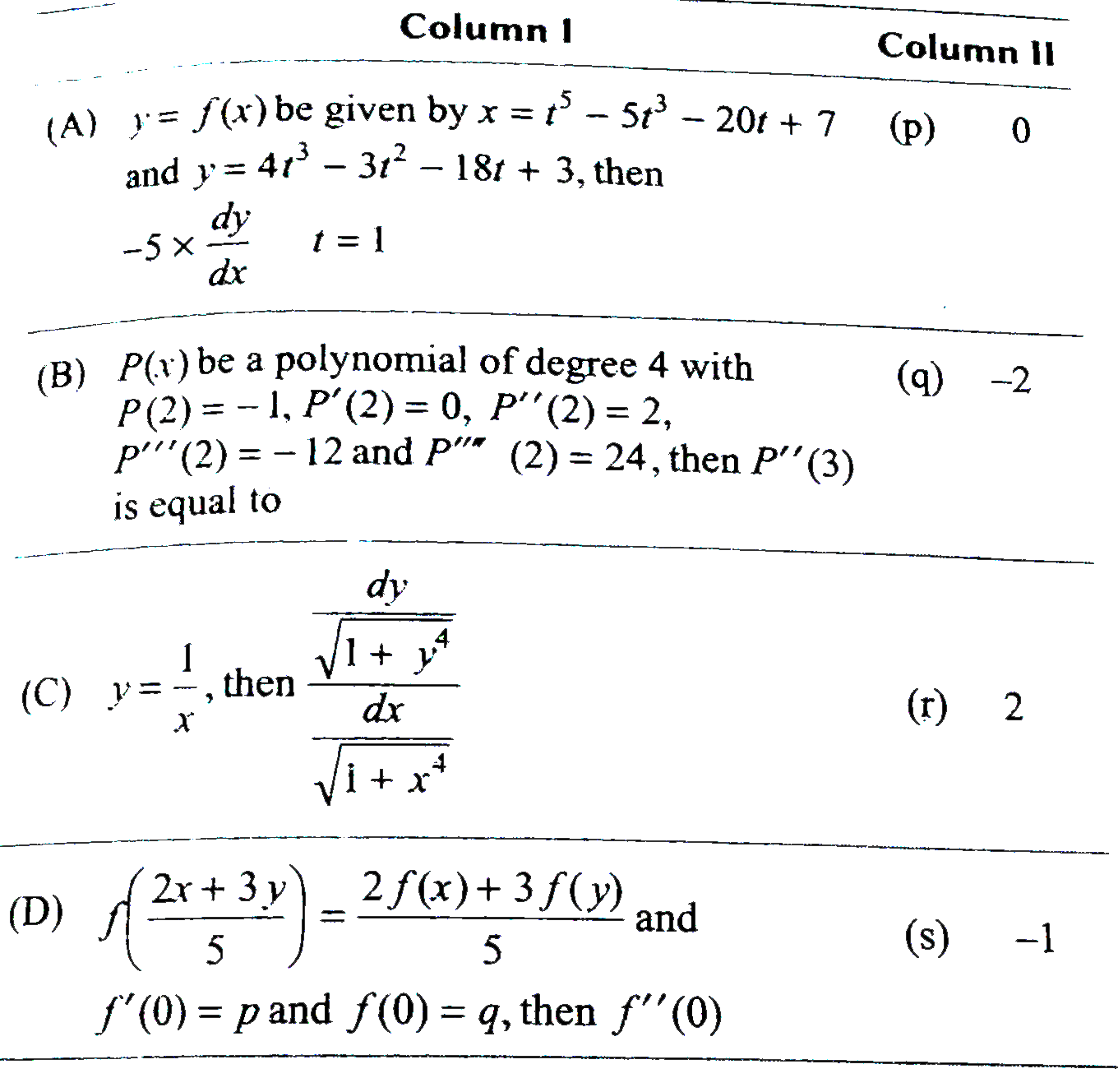Let the derivative of f(x) be defined as D∗f(x)=limh→0f2(x+h)−f2(x)h, where f2(x)={f(x)}2.
If u=f(x),v=g(x), then the value of D∗(u.v) isSolution in Punjabi
(a)(D∗u)v+(D∗v)u
(b)u2(D∗v)+v2(D∗u)
(c)D∗u+D∗v
(d)uvD∗(u+v)
The correct Answer is:B
Step by step video & image solution for Let the derivative of f(x) be defined as D^(**)f(x)=lim_(hrarr0)(f^(2)(x+h)-f^(2)(x))/(h), where f^(2)(x)={f(x)}^(2). If u=f(x),v=g(x), then the value of D^(**)(u.v) is by Maths experts to help you in doubts & scoring excellent marks in Class 12 exams.
Updated on:21/07/2023Topper's Solved these Questions
- DIFFERENTIATION BOOK - ARIHANT MATHSCHAPTER - DIFFERENTIATION EXERCISE - Differentiation Exercise 5:
2 Videos
- DIFFERENTIATION BOOK - ARIHANT MATHSCHAPTER - DIFFERENTIATION EXERCISE - Exercise (Subjective Type Questions)
14 Videos
- DIFFERENTIATION BOOK - ARIHANT MATHSCHAPTER - DIFFERENTIATION EXERCISE - Exercise (Statement I And Ii Type Questions)
8 Videos
- DIFFERENTIAL EQUATION BOOK - ARIHANT MATHSCHAPTER - DIFFERENTIAL EQUATION EXERCISE - Exercise (Questions Asked In Previous 13 Years Exam)
26 Videos
- DY / DX AS A RATE MEASURER AND TANGENTS, NORMALS BOOK - ARIHANT MATHSCHAPTER - DY / DX AS A RATE MEASURER AND TANGENTS, NORMALS EXERCISE - Exercise (Questions Asked In Previous 13 Years Exam)
7 Videos
Similar Questions
Match the entries between the following two columns.

View SolutionIf f(x)=x3+x2f'(1)+xf''(2)+xf''(2)+f'''(3) for all x∈R. then find f(x) independent of f'(1),f''(2)andf'''(3).
View SolutionConsider f(x)=xx2−1
Statement I Graph of f(x) is concave up for x>1.
Statement II If f(x) is concave up then f''(x)>0
View SolutionIf f:R−{−1}→Randf is differentiable function satisfies:
f((x)+f(y)+xf(y))=y+f(x)+yf(x)∀x,
y∈R−{_1} Find f(x).
View SolutionThe slope of the tangent to the curve (y−x5)2=x(1+x2)2 at the point (1,3) is.
View SolutionPeople living at Mars,instead of the usual definition of derivative Df(x) ,define a new kind of derivative D^(*)f(x) by the formula D^(*)f(x)=lim_(h rarr0)(f^(2)(x+h)-f^(2)(x))/(h) where f^(2)(x)means[f(x)]^(2) .If f(x)=x ln x then D^(*)f(x)|_(x=e) has the value (A)e(B)2e(C)4e(D) none
View SolutionD*f(x)=lim_(h rarr0)(f^(2)(x+h)-f^(2)(x))/(h) If f(x)=x ln x then D*f(x) at x=e equals
View SolutionLet the derivative of f(x) be defined as D*f(x)=lim_(h rarr0)(f^(2)(x+h)-f^(2)(x))/(h) where f^(2)(x)=(f(x))^(2) if u=f(x),v=g(x), then the value of D*{u.v} is
View SolutionLet f(x) be twice differentiablesuchthat f''(x)=-f(x),f'(x)=g(x), where f'(x) and f''(x) represent the first and second derivatives of f(x), respectively.Also if h(x)=(f(x))^(2)+(g(x))^(2) and h(5)=5 then h(10) is equal to
View SolutionLet f be a twice differentiable function such that
f''(x)=−f(x) and f'(x)=g(x).If h'(x)=[f(x)]2+[g(x)]2,
h(a)=8 and h(0)=2, then h(2)=
View SolutionLet the derivative of f(x) be defined as D∗f(x)=limh→0f2x+h−f2(x)h, where f2(x)={f(x)}2.
If u=f(x),v=g(x), then the value of D∗(uv) is.
View Solutionf(x)=1x হলে, প্রমাণ করো যে, limh→0f(2+h)−f(2)h=−14
View Solutionयदि D* f(x) = limh→0f2(x+h)−f2(x)h जहाँ f2(x)={f(x)}2
यदि u=f(x),v=g(x) तब D*(u.v) का मान होगा
View Solutionयदि D* f(x) = limh→0f2(x+h)−f2(x)h जहाँ f2(x)={f(x)}2
D*(tan x) का मान होगा।
View Solutionमाना f ( x ) सभी x∈R के लिए f2(x)−f(x)=x−1को संतुष्ट करता है एवं f(1)≠0 है यदि h(x)=∫(f(x)+f(−x)−f''(x)2−f'(x))f(x)d(x) है तो h(3)−h(2) का मान है।
View SolutionFor a differntiable function , define D∗f(x)=Lth→0f2(x+h)−f2(x)h where f'(x)=(f(x))2 for example, D∗f(x)=2x if f(x)=x,D∗f(x)=2sinxcosx if f(x)=sinxD∗f(x)=2e2x if f(x)=ex
If f(x)=tanx and g(x)=logx the D∗(fg)(1) =
View Solution
